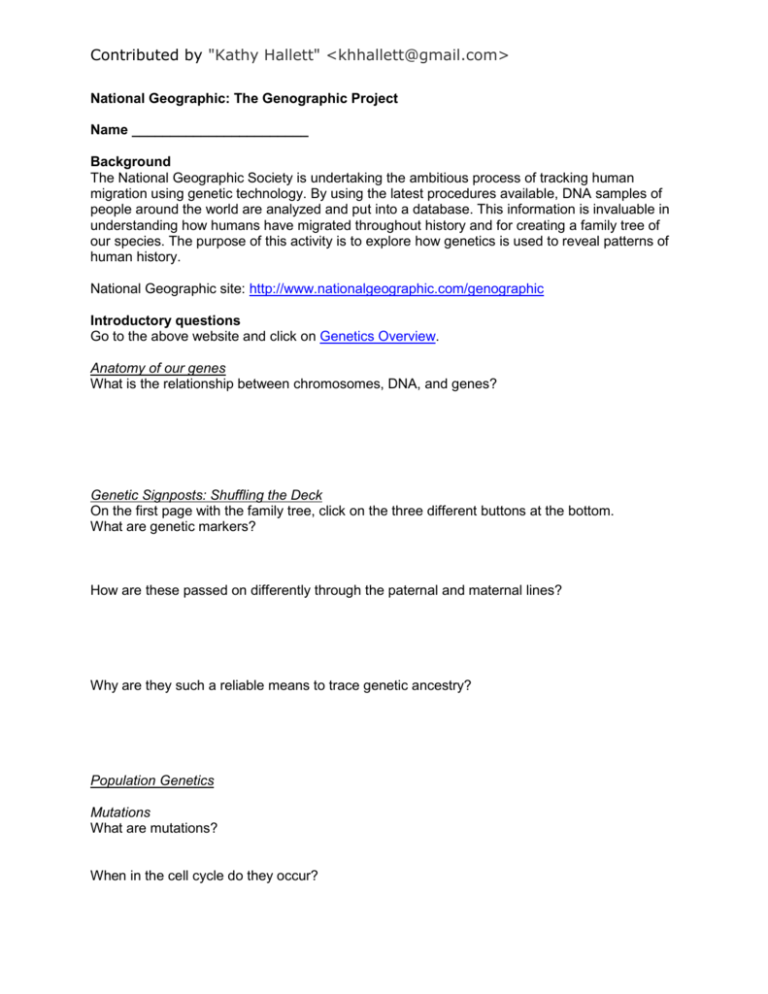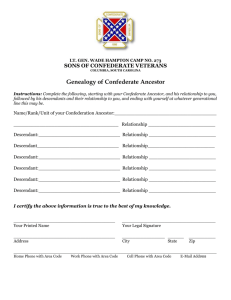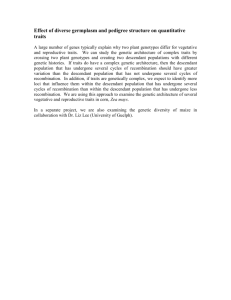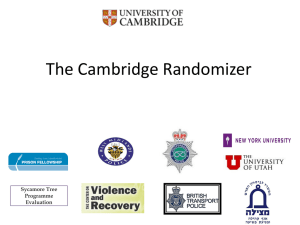Genographic Lesson
advertisement

Contributed by "Kathy Hallett" <khhallett@gmail.com> National Geographic: The Genographic Project Name _______________________ Background The National Geographic Society is undertaking the ambitious process of tracking human migration using genetic technology. By using the latest procedures available, DNA samples of people around the world are analyzed and put into a database. This information is invaluable in understanding how humans have migrated throughout history and for creating a family tree of our species. The purpose of this activity is to explore how genetics is used to reveal patterns of human history. National Geographic site: http://www.nationalgeographic.com/genographic Introductory questions Go to the above website and click on Genetics Overview. Anatomy of our genes What is the relationship between chromosomes, DNA, and genes? Genetic Signposts: Shuffling the Deck On the first page with the family tree, click on the three different buttons at the bottom. What are genetic markers? How are these passed on differently through the paternal and maternal lines? Why are they such a reliable means to trace genetic ancestry? Population Genetics Mutations What are mutations? When in the cell cycle do they occur? Contributed by "Kathy Hallett" <khhallett@gmail.com> How many base changes are typically different between parent and child? Genetic diversity On what chromosome is the mutation located on this page? What do the colored dots signify? Natural Selection What are symptoms of sickle cell disease? What is the advantage of being heterozygous for this trait? The map on this page shows both areas that are affected by malaria and allele frequency of the sickle cell allele. Click on “Sickle Cell allele frequency” and “Malaria zones” to shift between the two. What do you notice about sickle cell allele frequency in areas that are most affected by malaria? The Human Family Tree How is mitochondrial DNA passed down? How do genetic markers help create a family tree? Contributed by "Kathy Hallett" <khhallett@gmail.com> Activity Materials per group Index cards (60) Markers Descendant Randomizer cards Procedure Round One 1. Start the simulation by writing "1" on one side of a blank index card. 2. Draw a unique symbol (such as a heart, star, circle, etc.) on the other side of the card. 3. Pull a number from the Descendant Randomizer "hat." If you draw a zero in the first few rounds, draw again. (After the first few rounds a zero means no descendants, but you can’t stop at the beginning of this round!) Round Two 4. Take one index card for each descendant. Write a "2" on the back of each card. 5. Draw the "inherited" symbol from round one on each descendant card. If the number you pulled from the descendant randomizer hat says “RED”, draw a different symbol on one of the cards to introduce a new permanent marker into the game. The card should also have the original symbol. 6. Place those cards directly below the card from round one in a hierarchical tree structure, similar to the Genetic Diversity interactive diagram in the Population Genetics section of the Genographic site. The first card should be at the top with its "descendants" directly beneath it, and the descendants of those cards directly beneath those, etc. 7. For each card in round two, pull one number from the descendant randomizer hat to determine how many descendants each of the cards in this generation will have. Round Three 8. For each card in round two, take one index card for each descendant and write "3" on the back of each one. 9. Draw the symbol or symbols inherited from the corresponding round two cards. If you pulled a red number, add an additional symbol to one card to introduce a new permanent marker into the simulation. Be sure that each new symbol introduced is unique and has not been used before. 10. Place those cards directly under the corresponding round two cards in the tree structure. At this point, you should have one card from round one, one to three cards from round two, and one to nine cards from round three. 11. For each card in round three, pull one number from the descendant randomizer hat. Rounds Four-Ten 12. Repeat steps eight to eleven (noting the corresponding round number on the back of each descendant card) until you have approximately 15 to 20 cards in your final round. 13. As you work you should be arranging your index cards into a tree structure. 14. When your group has finished your simulation, draw your "permanent marker tree" on a piece of paper. Contributed by "Kathy Hallett" <khhallett@gmail.com> Analysis 1. Trade your cards with another group and attempt to arrange the other group’s set of cards into a permanent marker tree by only looking at the symbols. Do not look at the numbers. Draw a diagram of the other group’s descendants similar to the diagram that you drew. a. What can you determine looking only at the pictures of the other group’s? b. What is difficult or impossible to determine with this limited information? c. Compare your diagram with the group’s original diagram. How closely were you able to determine the correct tree? 2. What are mechanisms that could cause a mutation? 3. Children inherit genes from both parents. Why was only one set of genes followed in this activity? 4. Explore one of the time periods in the Atlas of the Human Journey section of the website. What do you find interesting about this site? Contributed by "Kathy Hallett" <khhallett@gmail.com> Drawing of your group’s family tree Contributed by "Kathy Hallett" <khhallett@gmail.com> Drawing of another group’s family tree








